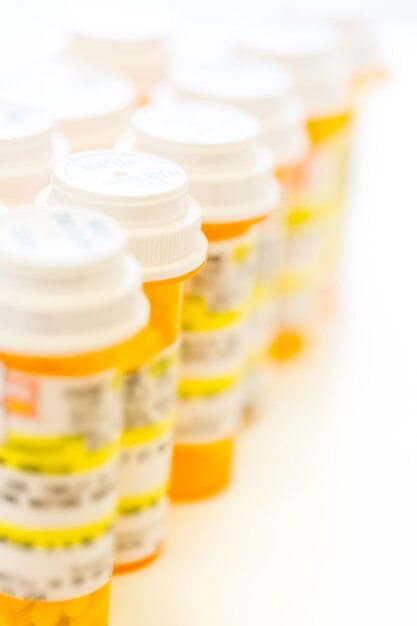How to Get Help Paying for Prescription Drugs: Programs & Resources for 2025

Navigating the costs of prescription drugs can be challenging; however, numerous programs and resources are available in 2025 to assist individuals and families in managing and affording their medications, including government assistance, pharmaceutical company programs, and nonprofit organizations.
The rising cost of prescription drugs can be a significant burden for many Americans. Understanding how to get help paying for prescription drugs: programs and resources for 2025 is crucial for accessing necessary medications without undue financial strain.
Understanding the Landscape of Prescription Drug Costs
The affordability of prescription medications is a growing concern for many individuals and families. Several factors contribute to the high cost of drugs in the United States, making it essential to explore available assistance programs and resources.
Factors Influencing Prescription Drug Prices
Several elements influence the pricing of prescription drugs, ranging from research and development costs to market competition and regulatory factors.
Understanding these elements can help individuals appreciate the complexities involved in drug pricing.
- Research and Development: Pharmaceutical companies invest heavily in researching, developing, and testing new medications, often passing these costs on to consumers.
- Market Exclusivity: Patents and market exclusivity periods allow manufacturers to be the sole providers of a drug for a set time, limiting competition and potentially driving up prices.
- Insurance Negotiation: The negotiation power of insurance companies and pharmacy benefit managers (PBMs) can impact drug prices, but these negotiations don’t always result in lower costs for consumers.
- Generic Competition: When patents expire, generic versions of drugs can enter the market, usually leading to lower prices due to increased competition.
High drug costs can lead to many people skipping doses or not filling their prescriptions. This results in negative health outcomes along with higher healthcare costs in the long run.
In conclusion, prescription drug prices are highly variable, influenced by a mixture of development costs, protections, and competitive market forces. Awareness of these dynamics helps individuals better navigate resources for financial support.
Government Programs for Prescription Drug Assistance
Government programs are designed to reduce the financial burden of prescription drugs. Federal and state initiatives offer various types of assistance, which can significantly lower out-of-pocket expenses for eligible individuals.
Medicare Part D and Extra Help Program
Medicare Part D provides prescription drug coverage to Medicare beneficiaries. For those with limited income and resources, the Extra Help program can further lower costs.
Understanding the eligibility requirements and benefits of these programs is vital for cost-effective access to medications.
- Medicare Part D: Enrollees pay a monthly premium and cost-sharing amounts for covered drugs, with the specific costs depending on the plan they choose.
- Extra Help: Also known as the Low-Income Subsidy (LIS), Extra Help can significantly reduce Part D premiums, deductibles, and copayments.
- Eligibility: Eligibility for Extra Help is based on income and asset limits, with different thresholds for individuals and married couples.
- Application Process: Individuals can apply for Extra Help through the Social Security Administration or their local Medicare office.
Explore Medicare’s official website for more details on Part D and the Extra Help program. Check eligibility requirements and how to apply.

These government based programs provide essential support for Americans, who often cannot afford prescription drugs. By understanding these programs, individuals can better manage their healthcare spending.
In summary, Medicare Part D and Extra Help can alleviate the financial pressure of prescription medications. Checking qualifications and applying can allow lower income patients to access the medicines they need without sacrificing other necessities.
Pharmaceutical Company Patient Assistance Programs
Many pharmaceutical companies offer Patient Assistance Programs (PAPs) to help individuals who cannot afford their medications. These programs provide drugs at reduced or no cost to eligible patients.
How to Apply and Qualify for PAPs
Applying for a PAP can involve a detailed process, but the potential savings can be significant. Understanding the eligibility criteria and application steps is essential.
Typically, enrollment depends on financial need and a lack of insurance.
- Research Programs: Identify pharmaceutical companies that manufacture the medications you need and research their PAP offerings.
- Check Eligibility: Review the eligibility criteria, which usually include income limits, insurance status, and residency requirements.
- Complete Application: Fill out the application form, providing accurate information about your income, household size, and medical condition.
- Provide Documentation: Gather supporting documents, such as tax returns, pay stubs, and a prescription from your healthcare provider.
These programs are essential for the uninsured and those facing high drug costs. The requirements are specific and must be carefully reviewed prior to submission.
Pharmaceutical PAPs are essential for many individuals facing high drug costs without insurance. Applying can be tedious, however, the savings received will allow patients to receive critical medicines.
Nonprofit Organizations Offering Prescription Drug Assistance
Nonprofit organizations play a crucial role in providing prescription drug assistance. These organizations offer a range of services, including financial support, access to discount cards, and information resources.

Key Nonprofit Programs and Resources
Several nonprofit organizations stand out for their commitment to helping individuals afford their medications. Exploring these resources can provide valuable support and options.
These nonprofits also offer help navigating government and pharmaceutical programs.
- Patient Advocate Foundation (PAF): Offers co-pay relief programs for patients with specific conditions, helping them afford their medications.
- Good Days: Provides financial assistance to patients with chronic diseases and conditions, helping them cover out-of-pocket medication costs.
- NeedyMeds: A comprehensive online resource that lists patient assistance programs, discount cards, and other resources for reducing medication costs.
By utilizing these resources, individuals can navigate the complexities of prescription drug costs and access the medications they need.
These non-profits are essential support systems providing access to life saving medicines. They also offer guidance on qualifications and other resources to assist low-income patients.
Ultimately, nonprofit programs provide avenues of recourse, and assist those navigating the complicated systems of prescription support. Patients with limited income may depend on these non-profits for the medicines they need.
State-Level Pharmaceutical Assistance Programs
Many states offer their own Pharmaceutical Assistance Programs (SPAPs) to help residents afford prescription drugs. These programs typically target specific populations, such as seniors or individuals with disabilities.
Eligibility and Benefits of SPAPs
Each SPAP has its own eligibility criteria and benefits. Understanding the specifics of your state’s program is essential for accessing these resources.
SPAPs may offer discounts, subsidies, or comprehensive medication coverage.
1. Program Types: Some SPAPs provide direct financial assistance, while others offer discounts or subsidies on prescription medications.
2. Coverage Details: Review the medications covered by the SPAP, as well as any limitations or restrictions on coverage.
3. Application Process: Understand the steps involved in applying for the SPAP, including required documentation and deadlines.
4. Coordination with Other Programs: Determine how the SPAP interacts with other assistance programs, such as Medicare Part D and Extra Help.
Enrollment may depend on household size, income, and medical history. Some programs also coordinate with other government assistance, providing discounts on insurance premiums.
State Programs give a financial foundation for citizens with limited income. SPAPs make prescription drugs more accessible, promoting better health outcomes.
In conclusion, SPAPs can play a vital role in supporting access to affordable medications.
Discount Cards and Pharmacy Savings Programs
Discount cards and pharmacy savings programs provide another avenue for reducing prescription drug costs. These programs offer discounts on medications at participating pharmacies.
Maximizing Savings with Discount Cards
Discount cards can offer significant savings, but it’s essential to understand how they work and how to maximize their benefits. Comparing different options and using them strategically can lower medication expenses.
Savings can be significant, especially for those without insurance.
- Compare Cards: Research different discount cards and compare their coverage, fees, and participating pharmacies.
- Check Drug Prices: Before using a discount card, check the discounted price against your insurance copay or the cash price to ensure the best deal.
- Use Generic Alternatives: If available, opt for generic versions of medications, as they are typically cheaper than brand-name drugs, even with a discount card.
- Participating Pharmacies: Use the discount card at participating pharmacies to ensure you receive the advertised discounts.
These programs can often be used without insurance and can provide substantial savings. Many pharmacies also offer their savings programs.
Understanding how to use discount cards and savings programs will result in lower healthcare expenses. Making informed choices will mean the best discounts possible.
Conclusion
Accessing affordable prescription medications is crucial for maintaining health and well-being. With so many resources available, understanding eligibility will allow more patients to qualify for available support.
| Key Point | Brief Description |
|---|---|
| 💰 Government Programs | Medicare Part D and Extra Help provide financial assistance for prescription drugs. |
| 💊 Patient Assistance | Pharmaceutical companies offer PAPs to help individuals who cannot afford their medications. |
| 🤝 Nonprofit Support | Nonprofit organizations provide financial support, discount cards, and information resources. |
| ⚕️ State Programs | Many states offer SPAPs to help residents afford prescription drugs. |
Frequently Asked Questions
▼
Medicare Part D is a federal program that subsidizes the costs of prescription drugs for Medicare beneficiaries. It’s an optional program for those enrolled in Medicare, offered through private companies that Medicare has approved.
▼
Patient Assistance Programs (PAPs) are run by pharmaceutical companies. They provide free or discounted medications to low-income, uninsured, or underinsured individuals who meet specific income and medical criteria.
▼
Yes, the Extra Help program has income and asset limits. These limits can change yearly, so it’s essential to check the most current guidelines on the Social Security Administration’s website to see if you qualify.
▼
A State Pharmaceutical Assistance Program (SPAP) is a state-run program that helps residents afford prescription drugs. SPAPs have specific eligibility such as age or having certain medical conditions, and financial situations.
▼
In some cases, yes. You can use a discount card if the discounted price is lower than your insurance copay. However, you cannot combine the discount card with your insurance to lower the copay further.
Conclusion
Navigating prescription drug costs can be complex, but with the right information and resources, individuals can enhance their health outcomes. Utilizing government programs, pharmaceutical assistance, nonprofit support, and discount cards are effective paths for affordability.
